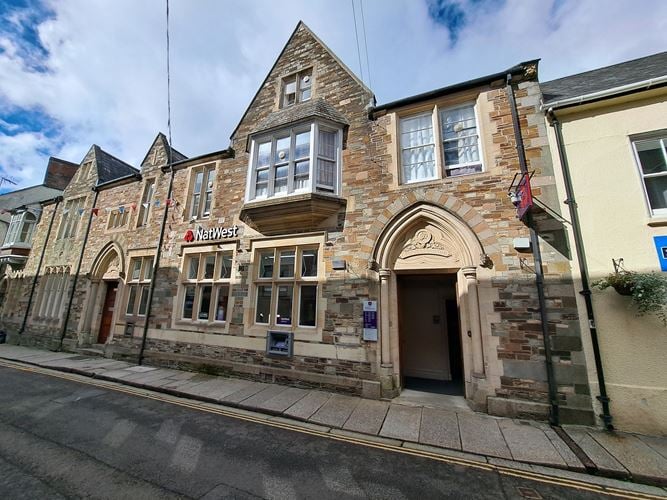IT seems like a lifetime ago now, but it was only in 2008 that the banks went cap in hand to the taxpayer seeking assistance to be bailed out amid the crash in the economy that happened at the time. It was also the beginning of a period of our lives that you could argue has never ended – because really, has the economy ever recovered since those days?
But, to the present day in 2025, where are the banks now? You know the routine – we’ve all seen it in news stories and when we walk down our high streets. Banks announce closures, tell us we can do it all at the Post Office or digitally, and you might get a banking hub. But who really benefits from the swathe of closures we’ve become accustomed to seeing in recent years?
The banking hubs themselves are a welcome addition to the high street and from my own experiences, both they and the Post Offices do a decent job of providing an amenity where the banks don’t. But the simple reality is this – just as much as they are a sticking plaster to a giant gaping wound, it is also the equivalent of replacing a railway service with a spacehopper.
The banks say that they’re closing all the branches because no one uses them anymore and when they try and justify that closure, they bring up all sorts of figures and statistics to justify their argument that the only person who uses their services is that sweet old lady from the WI and one of Snow White’s seven dwarves.
But if the banks are as underused as they claim, why is there a need for banking hubs if Mrs Miggins is doing all her banking using the app? The very fact there has been so much clamour for banking hubs in almost every town across Cornwall and so much outrage at the latest announcement of a closure directly contradicts the picture they paint of wall-to-wall tumbleweed and the odd spider’s web inside the bank branches.
Is it the elderly and less digitally abled who benefit from the bank closures?

Prior to the situation we find ourselves in now, you could go into see your local bank staff five days a week to cash your money, get assistance or discuss taking out an additional service such as a loan. You could see your bank while going into the town centre to visit the butchers or experience the thrill of a queue at the pharmacy to collect your prescription.
Now, not only are our high streets several shops emptier where the banks were once based, the replacement is seeing a community banker once a week on a certain day, which isn’t much good if you can’t make that day.
I thought of my now late and much missed Nan when I was thinking about how it must be for an elderly person in this digital first world. She lived on a farm on Bodmin Moor until she passed away in 2022 aged 84. Nan’s immediate modes of communication were two-fold in that it was either in person or using a landline phone. She had a basic mobile phone, which she barely knew how to use and never went near a computer or broadband – although, with this being Bodmin Moor, you can imagine how slow any internet speed would have been with it being miles from the nearest exchange and not connected to fibre.
Prior to the bank closures, Nan could venture into Bodmin to do some shopping, go to the bank to put some cash or a cheque in and go about her various business at a time where she was available and able to.
But if she was around now, how would she manage? Towards the end of her life, she was deaf as a post and therefore wouldn’t have even managed telephone banking and would have only been able to see a community banker on a selected day a week.
Which is fine, but if you’ve ever been a farmer or watched Clarkson’s Farm, you’ll know that farming doesn’t work by appointment particularly during the season where the cows and sheep drop their offspring like a shower of bullets in the middle of a warzone.
Mobile banking would have been impossible because of two reasons – the first being the mobile signal being about as visible as a seagull in a place where there aren’t any chips to nick and the second being she wouldn’t know how to use it anyway.
It isn’t just the elderly that this affects either. My father, for example is a working man and works during the week. So, while his ability to access the bank would have been restrictive around opening hours, the fact of the matter is if he had a day off, he could go to his bank, and it didn’t matter what day it was, or he could nip in on his way home from work if he finished before they closed.
Now, he’d have to hope that day off aligned with the day the community banker was in the banking hub. While an intelligent man, his digital skills aren’t the best and thus, he is also left behind in the digital banking revolution.
Then there’s the high streets they’ve left behind. There was a time where the bank branches were the lynchpin of those streets, with the need for their use often bringing extra footfall into those town centres as well as being an easy, convenient place for businesses to cash their takings.
How does a business in a town without a banking hub manage without having to travel miles to do it?
For all the banks tell us that the reason they are closing the branches being that no one uses the branches anymore, the simple truth is the evidence of need is the people, places and businesses left behind while they cash in the savings made from closing the branches and giving their hardworking staff their P45s.
Tell us your views
What are your views on the latest bank branch closures? Let us know by emailing [email protected]







Comments
This article has no comments yet. Be the first to leave a comment.